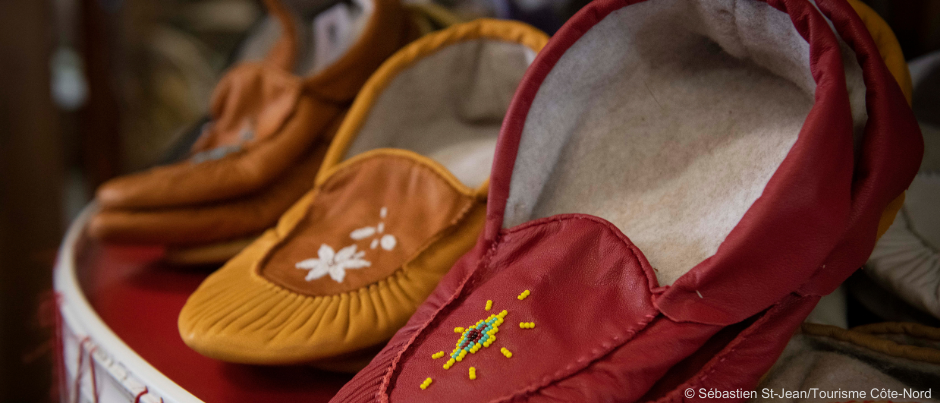The Québec maritime Blog

-
Micmac Interpretation Site of Gespeg
Camille Malleroni, L'Oiseau Rose
Meet the 3 First Nations in Eastern Québec
The maritime regions of Québec are home to three First Nations peoples, each with their own distinct identity, way of life, history and language: the Innu in Côte-Nord, the Mi’gmaq in Gaspésie and the Wolastoqiyik in Bas-Saint-Laurent. To visit these communities is to embark on a journey into the heart of centuries-old cultures and discover vibrant traditions, practices and belief systems.
Innu communities, Côte-Nord
Eight of the nine Innu communities in Québec are located on the vast territory of Côte-Nord. (The Innu are not to be confused with the Inuit, who mostly reside in the northern regions of Canada.) Seven of these communities are found along the St. Lawrence Estuary, while the eighth, the Innu Nation of Matimekush–Lac John, is a unique community located much further north, along the border with the province of Newfoundland and Labrador, in the heart of the taiga, which is also home to herds of woodland caribou.

Essipit is probably the best-known Innu community in Côte-Nord since the reserve is located just 30 minutes from Tadoussac. For years, Essipit Cruises has been offering whale-watching Zodiac excursions in the waters of the Saguenay–St. Lawrence Marine Park. You can also stay in the superb Natakam condo-hotels, which offer breathtaking views of the sea in the heart of the reserve, as well as participate in an activity to observe black bears in the company of experienced guides—a captivating adventure you won’t soon forget!
About a five-hour drive north of Baie-Comeau, at the Station Uapishka, the Innu of Pessamit offer a variety of activities to introduce you to their culture and traditional knowledge at the heart of Nitassinan, the magnificent ancestral homeland of the Innu. Providing accommodations, the station is used for scientific research and as a base camp for unique immersion experiences in the majestic Uapishka (Groulx) Mountains. Depending on what time of year you visit, you can go on hikes to discover the arctic tundra, climb mountaintops on snowshoes, explore the Manicouagan Reservoir (a lake created by an impact crater) during a kayaking excursion and much more.

On the Uashat Reserve near Sept-Îles, you’ll want to stop in at Atikuss, a maskisin (moccasin) economuseum that is also a workshop and boutique. Your visit will give you the opportunity to enjoy an immersive and educational experience during which you’ll learn about how moccasins, mukluks and other accessories are handcrafted on site by artisans inspired by traditional methods of beading and weaving.
The surprising and spectacular Mingan Archipelago National Park Reserve was long frequented by the Ekuanitshit First Nation, who hunted seals among the islands and islets in this area. During a visit to the park reserve, you can not only follow in their footsteps as you discover fascinating limestone monoliths in the archipelago, but also learn about this community’s history and formerly nomadic way of life. The Minuenimum (Wellness) activity (not available in 2025) offers a moment of cultural sharing that includes legends, dances and a traditional ritual, a unique purification ceremony that will immerse you in the culture of the Nutashkuan First Nation and offer you a glimpse of this community’s relationship with nature.
The Innu communities located along the Lower North Shore also offer a variety of cultural experiences. For example, the Unamen Shipu community provides the opportunity to participate in traditional lobster fishing using a dip net on the wild island of Apenepehekat. This rich and fascinating experience lasts several days and is a great way to meet members of this First Nation.
Mi’gmaq Nation, Gaspésie
Present on the Gaspé Peninsula for at least 3000 years before the Europeans arrived, the Mi’gmaq were the first to make contact with explorers. By the early 16th century, a Mi’gmaq community had settled permanently in Gaspé Bay. The tip of the Gaspé Peninsula is their ancestral territory: the name of the region originates from the Mi’gmaq word Gespeg, which means “land’s end.”

The Mi’gmaq of Gespeg don’t have any reserve land, but you can discover their culture and traditions at the Micmac Interpretation Site of Gespeg, a must-see attraction in Gaspé. Learn about their way of life in a faithful recreation of a traditional 17th-century village, where you can visit wigwams, discover trapping techniques and admire a birchbark canoe. Renowned for being excellent navigators, the Mi’gmaq build canoes with a unique design that includes rounded ends.
You’ll also discover how the community’s food sources change according to the seasons. You can sample bannock, a nourishing traditional Native bread, and visit the gift shop, which sells handcrafted items as well as delicious 100% Native maple products from the Sigewigus sugar shack.
The La Baie-des-Chaleurs sector is home to two other Mi’gmaq communities: Gesgapegiag, located on Chaleur Bay near the mouth of the Cascapédia River, and Listuguj, located at the mouth of the Restigouche River.
Wolastoqiyik Wahsipekuk First Nation, Bas-Saint-Laurent
The only Wolastoqey Nation on Québec territory, the Wolastoqiyik Wahsipekuk First Nation was granted reserve land in Cacouna along the shores of the St. Lawrence in the 19th century. Although this reserve no longer has any permanent residents, the Maison Denis-Launière is worth a visit. Built in 1891, this dwelling is the oldest in the community and now houses an interpretation centre. In addition, the community hosts a powwow every August, which offers a unique opportunity to immerse yourself in this culture by learning traditional dances and songs as well as enjoying fascinating culinary experiences.

Finally, you won’t want to miss a stop at the region’s latest must-see attraction. Located on the side of Gros-Cacouna Mountain, a new observatory overlooking the sea offers the opportunity to see marine mammals up close since a beluga nursery is located off the coast in this area. The Putep ’t-awt marine mammal observation site (putep ’t-awt means “beluga trail” in the Wolastoqey language) offers breathtaking views and also includes a 2-km (1.2-mi.) walking trail. This digital and interactive discovery trail provides deeper insights into Wolastoqey culture in an exceptional setting atop a mountain considered sacred by the community. (This landmark has been used by members of this First Nation for centuries as a gathering place and as a navigational aid on their way to Tadoussac, a place of exchange and trade with other Nations.)
The First Nations peoples in Québec have contributed enormously to shaping the history and character of this province, and the maritime regions of Québec are no exception. Today, our regions offer an ever-growing number of meaningful experiences that enable visitors to meet the First Nations communities who live here and gain a deeper understanding of their unique traditional knowledge, practices and cultural values.

(0) comment